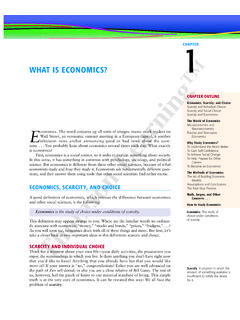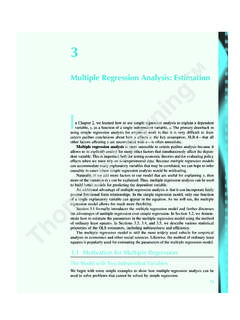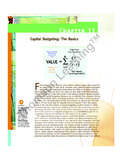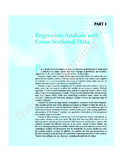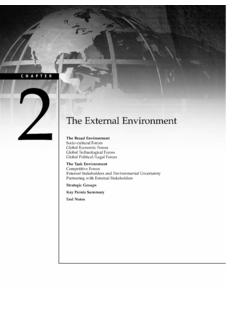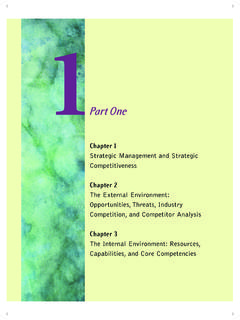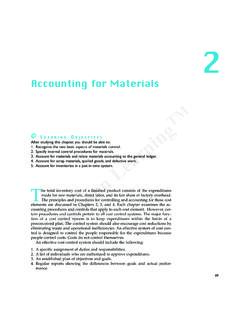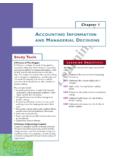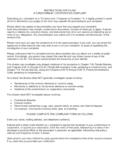Transcription of DECISION ANALYSIS Chapter 4
1 DECISION FORMULATIONI nfluence DiagramsPayoff TablesDecision MAKING WITHOUT PROBABILITIESO ptimistic ApproachConservative ApproachMinimax Regret MAKING WITH PROBABILITIESE xpected Value of Perfect ANALYSIS AND SENSITIVITY ANALYSISRisk AnalysisSensitivity ANALYSIS WITH SAMPLE INFORMATIONAn Influence DiagramA DECISION TreeDecision StrategyRisk ProfileExpected Value of Sample InformationEfficiency of Sample BRANCH PROBABILITIESD ecision ANALYSIS can be used to determine an optimal strategy when a de-cision maker is faced with several DECISION alternatives and an uncertain orrisk-filled pattern of future events. For example, a global manufacturermight be interested in determining the best location for a new plant. Sup-pose that the manufacturer has identified five DECISION alternatives corre-sponding to five plant locations in different countries.
2 Making the plantlocation DECISION is complicated by factors such as the world economy, de-mand in various regions of the world, labor availability, raw material costs,transportation costs, and so on. In such a problem, several scenarios couldbe developed to describe how the various factors combine to form the pos-sible uncertain future events. Then probabilities can be assigned to theevents. Using profit or cost as a measure of the consequence for each de-cision alternative and each future event combination, the best plant loca-tion can be when a careful DECISION ANALYSIS has been conducted, the uncer-tain future events make the final consequence uncertain. In some cases, theselected DECISION alternative may provide good or excellent results. Inother cases, a relatively unlikely future event may occur causing the se-lected DECISION alternative to provide only fair or even poor results.
3 Therisk associated with any DECISION alternative is a direct result of the un-certainty associated with the final consequence. A good DECISION ANALYSIS Chapter 4 3/8/01 10:35 AM Page 96 Chapter 4 DECISION Analysis97includes risk ANALYSIS . Through risk ANALYSIS the DECISION maker is provided with probabil-ity information about the favorable as well as the unfavorable consequences that may begin the study of DECISION ANALYSIS by considering problems having reasonably fewdecision alternatives and reasonably few possible future events. Influence diagrams andpayoff tables are introduced to provide a structure for the DECISION problem and to illustratethe fundamentals of DECISION ANALYSIS . We then introduce DECISION trees to show the se-quential nature of DECISION problems. DECISION trees are used to analyze more complexproblems and to identify an optimal sequence of decisions, referred to as an optimal deci-sion strategy.
4 Sensitivity ANALYSIS shows how changes in various aspects of the problem af-fect the recommended DECISION FORMULATIONThe first step in the DECISION ANALYSIS process is problem formulation. We begin with a ver-bal statement of the problem. We then identify the DECISION alternatives, the uncertain fu-ture events, referred to as chance events,and the consequencesassociated with eachdecision alternative and each chance event outcome. Let us begin by considering a con-struction project of the Pittsburgh Development Development Corporation (PDC) has purchased land, which will be the siteof a new luxury condominium complex. The location provides a spectacular view of down-town Pittsburgh and the Golden Triangle where the Allegheny and Monongahela riversmeet to form the Ohio River. PDC plans to price the individual condominium units between$300,000 and $1,400, has preliminary architectural drawings for three different-sized projects: one with30 condominiums, one with 60 condominiums, and one with 90 condominiums.
5 The fi-nancial success of the project depends upon the size of the condominium complex and thechance event concerning the demand for the condominiums. The statement of the PDC de-cision problem is to select the size of the new luxury condominium project that will lead tothe largest profit given the uncertainty concerning the demand for the the statement of the problem, it is clear that the DECISION is to select the best sizefor the condominium complex. PDC has the following three DECISION alternatives:d1 a small complex with 30 condominiumsd2 a medium complex with 60 condominiumsd3 a large complex with 90 condominiumsA factor in selecting the best DECISION alternative is the uncertainty associated with thechance event concerning the demand for the condominiums. When asked about the possibledemand for the condominiums, PDC s president acknowledged a wide range of possibili-ties, but decided that it would be adequate to consider two possible chance event outcomes:a strong demand and a weak DECISION ANALYSIS , the possible outcomes for a chance event are referred to as thestates of states of nature are defined so that one and only one of the possiblestates of nature will occur.
6 For the PDC problem, the chance event concerning the demandfor the condominiums has two states of nature:s1 strong demand for the condominiumss2 weak demand for the condominiumsThus, management must first select a DECISION alternative (complex size), then a stateof nature follows (demand for the condominiums), and finally a consequence will occur. Inthis case, the consequence is the PDC s 3/8/01 10:35 AM Page 97 Influence DiagramsAn influence diagramis a graphical device that shows the relationships among the deci-sions, the chance events, and the consequences for a DECISION problem. The nodesin an in-fluence diagram are used to represent the decisions, chance events, and or squares are used to depict DECISION nodes,circles or ovals are used to depictchance nodes,and diamonds are used to depict consequence nodes. The lines connecting thenodes, referred to as arcs,show the direction of influence that the nodes have on one shows the influence diagram for the PDC problem.
7 The complex size is the deci-sion node, demand is the chance node, and profit is the consequence node. The arcs con-necting the nodes show that both the complex size and the demand influence PDC s TablesGiven the three DECISION alternatives and the two states of nature, which complex sizeshould PDC choose? To answer this question, PDC will need to know the consequence as-sociated with each DECISION alternative and each state of nature. In DECISION ANALYSIS , we re-fer to the consequence resulting from a specific combination of a DECISION alternative anda state of nature as a table showing payoffs for all combinations of DECISION al-ternatives and states of nature is a payoff PDC wants to select the complex size that provides the largest profit, profit is usedas the consequence. The payoff table with profits expressed in millions of dollars is shown inTable Note, for example, that if a medium complex is built and demand turns out to bestrong, a profit of $14 million will be realized.
8 We will use the notation Vijto denote the pay-off associated with DECISION alternative iand state of nature j. Using Table , V31 20 indi-cates a payoff of $20 million occurs if the DECISION is to build a large complex (d3) and the strongdemand state of nature (s1) occurs. Similarly, V32 9 indicates a loss of $9 million if the de-cision is to build a large complex (d3) and the weak demand state of nature (s2) TreesAdecision treeprovides a graphical representation of the DECISION -making process. presents a DECISION tree for the PDC problem. Note that the DECISION tree shows the natu-98 QUANTITATIVE METHODS FOR BUSINESSP ayoffs can be expressed interms of profit, cost, time,distance, or any othermeasure appropriate for the DECISION problem AlternativesSmall complex (d1)Medium complex (d2)Large complex (d3) States of NatureStrong (s1)Weak (s2) ConsequenceProfitFIGURE DIAGRAM FOR THE PDC 3/8/01 10:35 AM Page 98 Chapter 4 DECISION Analysis99 State of NatureDecision AlternativeStrong Demand s1 Weak Demand s2 Small complex, d187 Medium complex, d2145 Large complex, d320 9 TABLE TABLE FOR THE PDC condominium PROJECT(PAYOFFS IN $ MILLION)ral or logical progression that will occur over time.
9 First, PDC must make a DECISION re-garding the size of the condominium complex (d1,d2,ord3). Then, after the DECISION isimplemented, either state of natures1ors2will occur. The number at each end point of thetree indicates the payoff associated with a particular sequence. For example the topmost pay-off of 8 indicates that an $8 million profit is anticipated if PDC constructs a small condo-minium complex (d1) and demand turns out to be strong (s1). The next payoff of 7 indicatesan anticipated profit of $7 million if PDC constructs a small condominium complex (d1) anddemand turns out to be weak (s2). Thus, the DECISION tree shows graphically the sequencesof DECISION alternatives and states of nature that provide the six possible payoffs for DECISION tree in Figure has four nodes, numbered 1 4. Squares are used to de-pict DECISION nodes and circles are used to depict chance nodes.
10 Thus, node 1 is a decisionnode, and nodes 2, 3, and 4 are chance nodes. The branches, which connect the nodes, leav-ing the DECISION node correspond to the DECISION alternatives. The branches leaving eachchance node correspond to the states of nature. The payoffs are shown at the end of thestates-of-nature branches. We now turn to the question: How can the DECISION maker use theinformation in the payoff table or the DECISION tree to select the best DECISION alternative?Several approaches may be you have a payoff table,you can develop a decisiontree. Try Problem 1(a).Weak (s2)Strong (s1)Weak (s2)Strong (s1)Weak (s2)Strong (s1)12348714520 9 Small (d1)Medium (d2)Large (d3)FIGURE TREE FOR THE PDC condominium PROJECT(PAYOFFS IN $ MILLION) 3/8/01 10:35 AM Page 99100 QUANTITATIVE METHODS FOR BUSINESSNOTES AND in problem solving agree that the firststep in solving a complex problem is to decom-pose it into a series of smaller subproblems.


